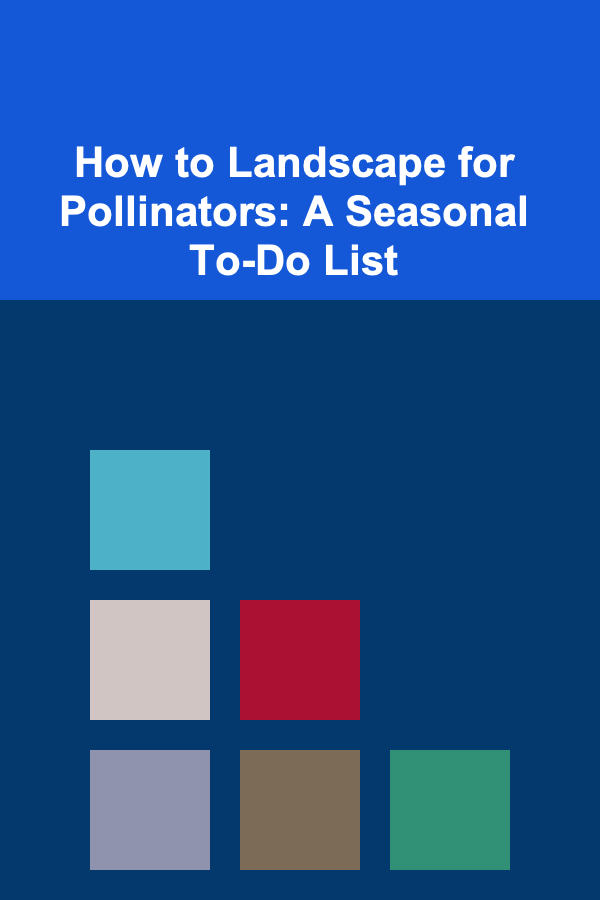
How to Landscape for Pollinators: A Seasonal To-Do List
ebook include PDF & Audio bundle (Micro Guide)
$12.99$5.99
Limited Time Offer! Order within the next:

Landscaping for pollinators has become a crucial practice in modern gardening and ecological conservation. Pollinators such as bees, butterflies, hummingbirds, and bats are vital to the health of our ecosystems. They play an essential role in pollinating plants, including many of the fruits, vegetables, and flowers that are critical to both our food systems and natural biodiversity. However, pollinator populations are facing significant threats from habitat loss, climate change, pesticide use, and pollution. As gardeners, landscapers, and homeowners, we have an important role to play in reversing this decline by creating landscapes that support and nurture pollinators.
In this article, we will provide a seasonal to-do list that outlines what you can do throughout the year to support pollinators in your garden. By following these steps, you can create a welcoming environment for these important creatures, from early spring through to the late fall.
Spring: Rebuilding and Preparing for Pollinators
1. Plant Early-Flowering Plants
In spring, the first flowers to bloom are a critical food source for pollinators after a long winter. Planting early-blooming species can provide much-needed nectar for bees, butterflies, and other pollinators. Some of the best early bloomers include:
- Crocuses
- Snowdrops
- Dandelions (often overlooked but very important for early bees)
- Willows (particularly the pussy willow)
- Violets
These plants give pollinators an early start to the season, allowing them to feed and build strength for the months ahead.
2. Choose Native Plants
Native plants are the best choice for supporting local pollinators because they have evolved together, meaning they provide the specific nectar, pollen, and habitat that native species rely on. Research the native plants in your area that support pollinators. These plants tend to require fewer pesticides and fertilizers, which makes them a more environmentally friendly option.
3. Provide Habitat for Pollinators
Pollinators need more than just food---they need safe spaces to nest and breed. In spring, focus on providing habitat by incorporating structures like:
- Bee hotels: These structures are designed to provide solitary bees with nesting sites. You can either buy pre-made ones or make your own using bamboo or drilled wooden blocks.
- Dead wood: Leaving a patch of dead wood or old tree stumps in your garden provides valuable nesting sites for many species of bees and beetles.
- Leaf litter: Leaving fallen leaves or grass clippings in your garden offers shelter for ground-nesting bees and other pollinators.
- Hollow stems: Many bees, including mason bees, nest in hollow plant stems. Consider leaving the tops of tall plants like raspberries or sunflowers intact, or using plant supports with hollow tubes.
4. Avoid Pesticides
Spring is a time when gardeners often turn to pesticides to combat early pests. However, many common pesticides are harmful to pollinators. Instead, opt for natural pest control methods like companion planting, introducing beneficial insects (e.g., ladybugs, lacewings), or using organic pesticides that are safe for pollinators.
Summer: Thriving in the Heat
5. Maintain a Diverse Range of Flowers
By summer, your garden should be in full bloom. To ensure continuous food sources for pollinators, make sure to include a variety of flowers that bloom at different times throughout the season. Here are a few key plants to add to your garden in summer:
- Lavender (attracts bees and butterflies)
- Black-eyed Susans
- Coneflowers
- Bee balm
- Goldenrod
This ensures that as one plant stops blooming, another is ready to take its place, providing a continuous supply of nectar and pollen throughout the summer months.
6. Provide Fresh Water
Pollinators also need access to clean water, especially during the hot summer months. Set up shallow water dishes, birdbaths, or small ponds with a few rocks or sticks sticking out of the water to give them a place to land and drink. Be sure to change the water regularly to avoid standing water and mosquito breeding.
7. Create Shady Spots
On particularly hot days, pollinators can become stressed, and providing shaded areas can help them thrive. You can create shady spots by planting tall plants or installing structures like pergolas or trellises with climbing plants like sweet peas or morning glories.
8. Support Pollinator-Friendly Insects
Encourage the presence of beneficial insects like ladybugs, predatory beetles, and lacewings, which will help control pest populations without harming pollinators. Avoid using broad-spectrum insecticides, which can harm not only pests but also beneficial pollinators.
Fall: Preparing for the Cold
9. Plant Fall-Blooming Plants
As the weather cools down, there are still many pollinators active, especially late-blooming species like goldenrods, asters, and fall chrysanthemums. These plants can provide nectar to bees, butterflies, and other pollinators as they prepare for winter. Planting a mix of late-blooming flowers will help support pollinators as they gather their final meals before winter.
10. Leave Your Garden Unfinished
In fall, it's important to resist the urge to clean up your garden too thoroughly. Many pollinators overwinter in garden debris, fallen leaves, or hollow stems. Instead of removing dead plant material, consider leaving it in place for winter. This provides shelter for overwintering insects, including butterflies, bees, and other pollinators. If you have a compost pile, it can also be a great habitat for beneficial insects.
11. Build a Pollinator-Friendly Winter Habitat
As the weather gets colder, many pollinators need a safe place to overwinter. You can help by creating a winter-friendly environment by:
- Leaving plant stems standing: Bees often overwinter in hollow stems. Leave tall, herbaceous plants like goldenrod or sunflowers standing.
- Providing shelter for butterflies: If you know where butterflies roost during the winter months, try to create a sheltered spot for them by placing logs or leaf piles where they can huddle together to stay warm.
12. Plan for Next Spring
Fall is also a great time to start planning for next year's pollinator garden. Take notes on which plants thrived and which ones your pollinators were most attracted to. This gives you the opportunity to refine your garden plan for next spring, ensuring that your landscape continues to provide vital resources for pollinators in the seasons to come.
Year-Round Considerations
While the tasks listed above are designed to help you support pollinators during specific seasons, there are a few year-round strategies that can also make a significant difference:
- Provide a mix of plant types: Include trees, shrubs, and flowers in your garden. Different types of plants attract different types of pollinators.
- Avoid monocultures: A garden filled with one type of plant is much less valuable to pollinators than a diverse, multi-species garden.
- Consider the environment: In addition to flowers and habitat, consider creating a garden that provides good air quality and minimizes pollutants. Avoid using harmful chemicals or non-organic gardening products.
Conclusion
Landscaping for pollinators is a rewarding endeavor that not only enhances your garden but also contributes to the broader ecological health of your community. By following this seasonal to-do list, you can create an environment that attracts and supports a wide variety of pollinators throughout the year. Whether you're planting for early spring blooms, providing habitat during the summer heat, or preparing for winter shelter, every action you take can have a positive impact on the health of pollinator populations.
As pollinators continue to face challenges from human activity, habitat loss, and climate change, we can all do our part to ensure that these vital creatures have the resources they need to thrive. With a little effort and commitment, your garden can become a sanctuary for pollinators, benefiting not only the creatures you welcome but the entire ecosystem as well.
Reading More From Our Other Websites
- [Personal Care Tips 101] How to Develop a Face Care Routine Tailored to Your Skin Type
- [Organization Tip 101] Why You Should Use Color-Coded Bins for Easy Sorting
- [Home Space Saving 101] How to Make Your Small Kitchen Feel Bigger with Simple Changes
- [Home Holiday Decoration 101] How to Use Lighting to Enhance Your Holiday Decor
- [Personal Care Tips 101] How to Choose the Best Makeup Primer for Wedding Makeup
- [Personal Care Tips 101] How to Use Antiperspirant to Feel Fresh and Dry All Day Long
- [Home Renovating 101] How to Arrange Furniture Like a Pro: Tips for Any Room
- [Personal Investment 101] How to Invest in Green Energy: A Sustainable Approach to Personal Finance
- [Scrapbooking Tip 101] Budget-Friendly Scrapbooking Hacks: Create Pro‑Look Layouts for Less
- [Home Pet Care 101] How to Choose the Best Pet Bed for Your Furry Friend

How to Financially Prepare for Buying Your First Home
Read More
How to Use Clear Containers for Small Items in Drawers
Read More
How To Master Video Post-Production
Read More
How To Explore the History of Ancient China
Read More
How To Evaluate a Movie's Pacing and Editing
Read More
How to Grocery Shop on a Budget with a Toddler: A Checklist
Read MoreOther Products

How to Financially Prepare for Buying Your First Home
Read More
How to Use Clear Containers for Small Items in Drawers
Read More
How To Master Video Post-Production
Read More
How To Explore the History of Ancient China
Read More
How To Evaluate a Movie's Pacing and Editing
Read More